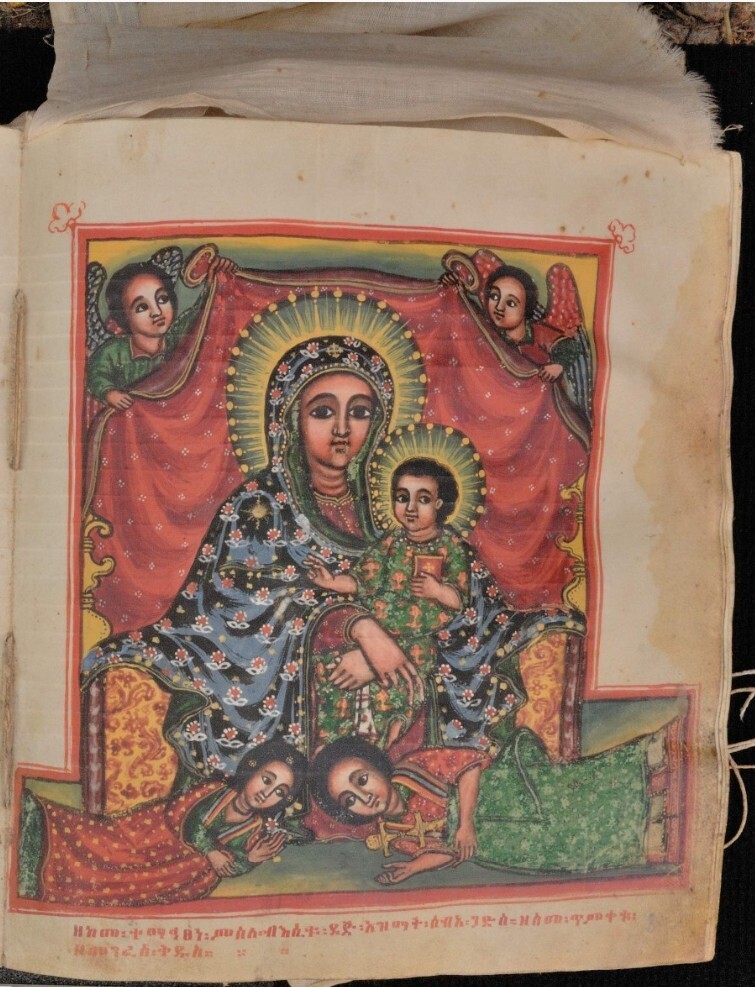Share the Stories That Shape Our World
Your support brings voices of the past to life today.
Veiling the Holy: Textiles in Ethiopic Manuscripts
This story is part of an ongoing series of editorials in which HMML curators and catalogers examine how specific themes appear across HMML’s digital collections. From the Eastern Christian collection, Dr. Jeremy R. Brown has this story about Textiles.

The monk cried out, “So now I will go and petition and beg my Lady Mary, which in Hebrew is Mariham, Twofold Holy Virgin, the Ark of the Holy Spirit, for she is the rescuer for the tormented, the comforter for mourners, and the giver of relief for those who are burdened.” Having said this, that monk got ready and went to the church of Our Lady Mary, which in Hebrew is Mariham, Twofold Holy Virgin, the Ark of the Holy Spirit. He stood in front of the altar, unveiled her icon, and bowed many times.
—“The Monk Expelled for Lack of Payment”, translated by Jeremy R. Brown and Ekaterina Pukhovaia from EMML 2275, collection of Darafo Māryām Church, Šawā Province, Ethiopia.
Textiles play a vibrant role in the churches of Ethiopia and Eritrea. Curtains divide the sections of the church. Vestments are worn by the clergy celebrating the service. Veils enshroud the icons adorning the walls. Embroidered cloths cover the altar. Textiles protect the covers of manuscripts. Ethiopic literature often refers to these varied uses of textiles, with descriptions of the material and depictions of their use.
The regular reference to textiles in Ethiopic texts highlights their prominence in the liturgical life of the Church. Manuscripts describe believers unveiling icons to venerate them and priests going behind the curtain that surrounds the Holy of Holies. Textiles often appear in the inventories of church possessions. In a particular Miracle of Mary story, the most spectacular items possessed by the church are “beautiful feast garments, liturgical clothes for the Sabbath, altar linens, and clerical vestments” (Non-Christian Thieves Struck by Lightning, translated by Mehari Worku from EMML 2275).

In the physical act of creating books, the Ethiopic manuscript tradition makes use of textiles in several different ways. Ethiopic manuscripts are traditionally copied on parchment made of sheep or goat skin, and then the parchment is bound between covers made of wood boards. One use of textiles in manuscripts is as a wrap for these wood boards. Sometimes this wrap goes directly over the wood and in other instances the wrap protects intricately stamped leather adhered to the covers and spine of the manuscript.


Textiles also appear on the interior of covers as pastedowns under leather turn-ins. While the use of textiles on the outside of covers has ascetic and utilitarian purposes, the pastedowns seem to be motivated by the beauty of the fabric.

Just as in churches, icons within manuscripts are oftentimes veiled with cloth. The veil must be lifted to venerate the icon, both inside the pages of a manuscript and upon the walls of a church. In addition to the ritual aspects of veiling a holy icon, there is also a practical benefit of protecting the painting from being damaged by rubbing against the facing page. The vibrancy of so many paintings in Ethiopic manuscripts hundreds of years after their creation may be in some part due to the protection afforded by the fabric veil.

The textiles found on the covers or between the folios of Ethiopic manuscripts are also visually represented in manuscript iconography. Illuminations depict curtains hanging in the churches. Saints are wrapped in embroidered fabrics with ornate patterns. Patrons and saints clutch handkerchiefs. The fabrics depicted in the iconographic tradition closely resemble those that physically appear in Ethiopic manuscripts and churches.

An important research project on the use of textiles in Christian Ethiopian manuscripts is currently underway: the Textiles in Ethiopian Manuscripts project, directed by Michael Gervers and Sarah Fee. Their project has identified textiles in nearly 2,000 Ethiopic manuscripts and their research explores textiles as a witness to global trade networks. The textiles that they have analyzed indicate trade connections between Ethiopia and India, Europe, the Middle East, and East Asia. Several hundred of the manuscripts in the Textiles in Ethiopian Manuscripts database are available in HMML Reading Room.
Further Reading:
Rosemary Crill, “Beneath the Covers,” Hali 218 (Winter 2023), 56–65.
Sarah Fee, Michael Gervers, and Carolina Melis, “Uncovering History from Textile Pastedowns in Ethiopian Manuscripts: A Singular and Complex Research Project,” Rassegna di Studi Etiopici vol. 6, series 3 (2022), 295–305.
Melissa Moreton and Suzanne Conklin Akbari, editors, Textiles in Manuscripts: A Local and Global History of the Book (Berlin: De Gruyter, 2025).



